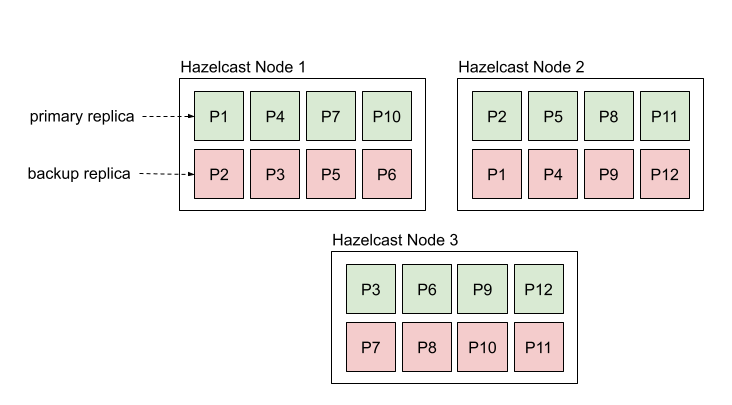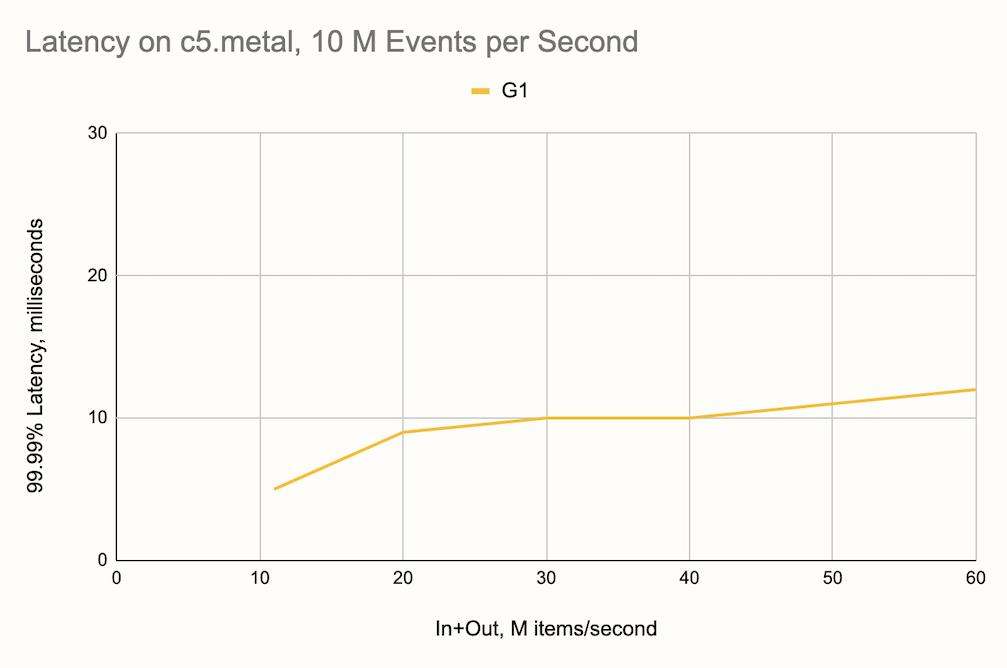Hazelcast is a distributed computation and storage platform for consistently low-latency querying, aggregation and stateful computation against event streams and traditional data sources. It allows you to quickly build resource-efficient, real-time applications. You can deploy it at any scale from small edge devices to a large cluster of cloud instances.
A cluster of Hazelcast nodes share both the data storage and computational load which can dynamically scale up and down. When you add new nodes to the cluster, the data is automatically rebalanced across the cluster and currently running computational tasks (known as jobs) snapshot their state and scale with processing guarantees.
Hazelcast provides a platform that can handle multiple types of workloads for building real-time applications.
- Stateful data processing over streaming data or data at rest
- Querying streaming and batch data sources directly using SQL
- Ingesting data through a library of connectors and serving it using low-latency SQL queries
- Pushing updates to applications on events
- Low-latency queue-based or pub-sub messaging
- Fast access to contextual and transactional data via caching patterns such as read/write-through and write-behind
- Distributed coordination for microservices
- Replicating data from one region to another or between data centers in the same region
- Stateful and fault-tolerant data processing and querying over data streams and data at rest using SQL or dataflow API
- A comprehensive library of connectors such as Kafka, Hadoop, S3, RDBMS, JMS and many more
- Distributed messaging using pub-sub and queues
- Distributed, partitioned, queryable key-value store with event listeners, which can also be used to store contextual data for enriching event streams with low latency
- A production-ready Raft-implementation which allows lineralizable (CP) concurrency primitives such as distributed locks.
- Tight integration for deploying machine learning models with Python to a data processing pipeline
- Cloud-native, run everywhere architecture
- Zero-downtime operations with rolling upgrades
- At-least-once and exactly-once processing guarantees for stream processing pipelines
- Data replication between data centers and geographic regions using WAN
- Microsecond performance for key-value point lookups and pub-sub
- Unique data processing architecture results in 99.99% latency of under 10ms for streaming queries with millions of events per second.
- Client libraries in Java, Python, Node.js, .NET, C++ and Go
Hazelcast provides distributed in-memory data structures which are partitioned, replicated and queryable. One of the main use cases for Hazelcast is for storing a working set of data for fast querying and access.
The main data structure underlying Hazelcast, called IMap is a key-value store
which has a rich set of features, including:
- Integration with data sources for one time or continuous ingestion
- Read-through and write-through caching patterns
- Indexing and querying through SQL
- Processing entries in place for atomic updates
- Expiring items automatically based on certain criteria like TTL or last access time
- Near cache for caching entries on the client
- Listeners for pushing changes to clients
- Data Replication between datacenters (Enterprise version only)
- Persistence of data on disk (Enterprise version only)
Hazelcast stores data in partitions, which are distributed to all the nodes. You can increase the storage capacity by adding additional nodes, and if one of the nodes go down, the data is restored automatically from the backup replicas.
You can interact with maps using SQL or a programming language client of your choice. You can create and interact with a map as follows:
CREATE MAPPING myMap (name varchar EXTERNAL NAME "__key", age INT EXTERNAL NAME "this")
TYPE IMap
OPTIONS ('keyFormat'='varchar','valueFormat'='int');
INSERT INTO myMap VALUES('Jake', 29);
SELECT * FROM myMap;The same can be done programmatically as follows using one of the supported programming languages. Here are some exmaples in Java and Python:
var hz = HazelcastClient.newHazelcastClient();
IMap<String, Integer> map = hz.getMap("myMap");
map.set(Alice, 25);import hazelcast
client = hazelcast.HazelcastClient()
my_map = client.get_map("myMap")
age = my_map.get("Alice").result()Other programming languages supported are C#, C++, Node.js and Go.
Alternatively, you can ingest data directly from the many sources supported using SQL:
CREATE MAPPING csv_ages (name VARCHAR, age INT)
TYPE File
OPTIONS ('format'='csv',
'path'='/data', 'glob'='data.csv');
SINK INTO myMap
SELECT name, age FROM csv_ages;Hazelcast also provides additional data structures such as ReplicatedMap, Set, MultiMap and List. For a full list, refer to the distributed data structures section of the docs.
Hazelcast has a built-in data processing engine called Jet. Jet can be used to build both streaming and batch data pipelines that are elastic. You can use it to process large volumes of real-time events or huge batches of static datasets. To give a sense of scale, a single node of Hazelcast has been proven to aggregate 10 million events per second with latency under 10 milliseconds. A cluster of Hazelcast nodes can process billion events per second.
An application which aggregates millions of sensor readings per second with 10-millisecond resolution from Kafka looks like the following:
var hz = Hazelcast.bootstrappedInstance();
var p = Pipeline.create();
p.readFrom(KafkaSources.<String, Reading>kafka(kafkaProperties, "sensors"))
.withTimestamps(event -> event.getValue().timestamp(), 10) // use event timestamp, allowed lag in ms
.groupingKey(reading -> reading.sensorId())
.window(sliding(1_000, 10)) // sliding window of 1s by 10ms
.aggregate(averagingDouble(reading -> reading.temperature()))
.writeTo(Sinks.logger());
hz.getJet().newJob(p).join();Use the following command to deploy the application to the server:
bin/hazelcast submit analyze-sensors.jarJet supports advanced streaming features such as exactly-once processing and watermarks.
Jet also powers the SQL engine in Hazelcast which can execute both streaming and batch queries. Internally, all SQL queries are converted to Jet jobs.
CREATE MAPPING trades (
id BIGINT,
ticker VARCHAR,
price DECIMAL,
amount BIGINT)
TYPE Kafka
OPTIONS (
'valueFormat' = 'json',
'bootstrap.servers' = 'kafka:9092'
);
SELECT ticker, ROUND(price * 100) AS price_cents, amount
FROM trades
WHERE price * amount > 100;
+------------+----------------------+-------------------+
|ticker | price_cents| amount|
+------------+----------------------+-------------------+
|EFGH | 1400| 20|Hazelcast provides lightweight options for adding messaging to your application. The two main constructs for messaging are topics and queues.
Topics provide a publish-subscribe pattern where each message is fanned out to multiple subscribers. See the examples below in Java and Python:
var hz = Hazelcast.bootstrappedInstance();
ITopic<String> topic = hz.getTopic("my_topic");
topic.addMessageListener(msg -> System.out.println(msg));
topic.publish("message");topic = client.get_topic("my_topic")
def handle_message(msg):
print("Received message %s" % msg.message)
topic.add_listener(on_message=handle_message)
topic.publish("my-message")For examples in other languages, please refer to the docs.
Queues provide FIFO-semantics and you can add items from one client and remove from another. See the examples below in Java and Python:
var client = Hazelcast.newHazelcastClient();
IQueue<String> queue = client.getQueue("my_queue");
queue.put("new-item")import hazelcast
client = hazelcast.HazelcastClient()
q = client.get_queue("my_queue")
my_item = q.take().result()
print("Received item %s" % my_item)For examples in other languages, please refer to the docs.
Follow the Getting Started Guide to install and start using Hazelcast.
Read the documentation for in-depth details about how to install Hazelcast and an overview of the features.
You can use the following channels for getting help with Hazelcast:
- Hazelcast mailing list
- Slack for chatting with the development team and other Hazelcast users.
- Stack Overflow
Thanks for your interest in contributing! The easiest way is to just send a pull request. Have a look at the issues marked as good first issue for some guidance.
Building Hazelcast requires minimum JDK 1.8. Pull the latest source from the repository and use Maven install (or package) to build:
$ git pull origin master
$ mvn clean package -DtestsAdditionally, there is a quick build activated by setting the -Dquick system
property that skips tests, checkstyle validation, javadoc and source plugins and
does not build extensions and distribution modules.
Take into account that the default build executes thousands of tests which may take a considerable amount of time. Hazelcast has 3 testing profiles:
- Default: Type
mvn testto run quick/integration tests (those can be run in parallel without using network). - Slow Tests: Type
mvn test -P slow-testto run tests that are either slow or cannot be run in parallel. - All Tests: Type
mvn test -P all-teststo run all tests serially using network.
When you create a pull request (PR), it must pass a build-and-test procedure. Maintainers will be notified about your PR, and they can trigger the build using special comments. These are the phrases you may see used in the comments on your PR:
run-lab-run- run the default PR builderrun-windows- run the tests on a Windows machine (HighFive is not supported here)run-with-ibm-jdk-8- run the tests with IBM JDK 8run-cdc-debezium-tests- run all tests in theextensions/cdc-debeziummodulerun-cdc-mysql-tests- run all tests in theextensions/cdc-mysqlmodulerun-cdc-postgres-tests- run all tests in theextensions/cdc-postgresmodule
Where not indicated, the builds run on a Linux machine with Oracle JDK 8.
Source code in this repository is covered by one of two licenses:
The default license throughout the repository is Apache License 2.0 unless the header specifies another license.
Thanks to YourKit for supporting open source software by providing us a free license for their Java profiler.
We owe (the good parts of) our CLI tool's user experience to picocli.
Copyright (c) 2008-2021, Hazelcast, Inc. All Rights Reserved.
Visit www.hazelcast.com for more info.






